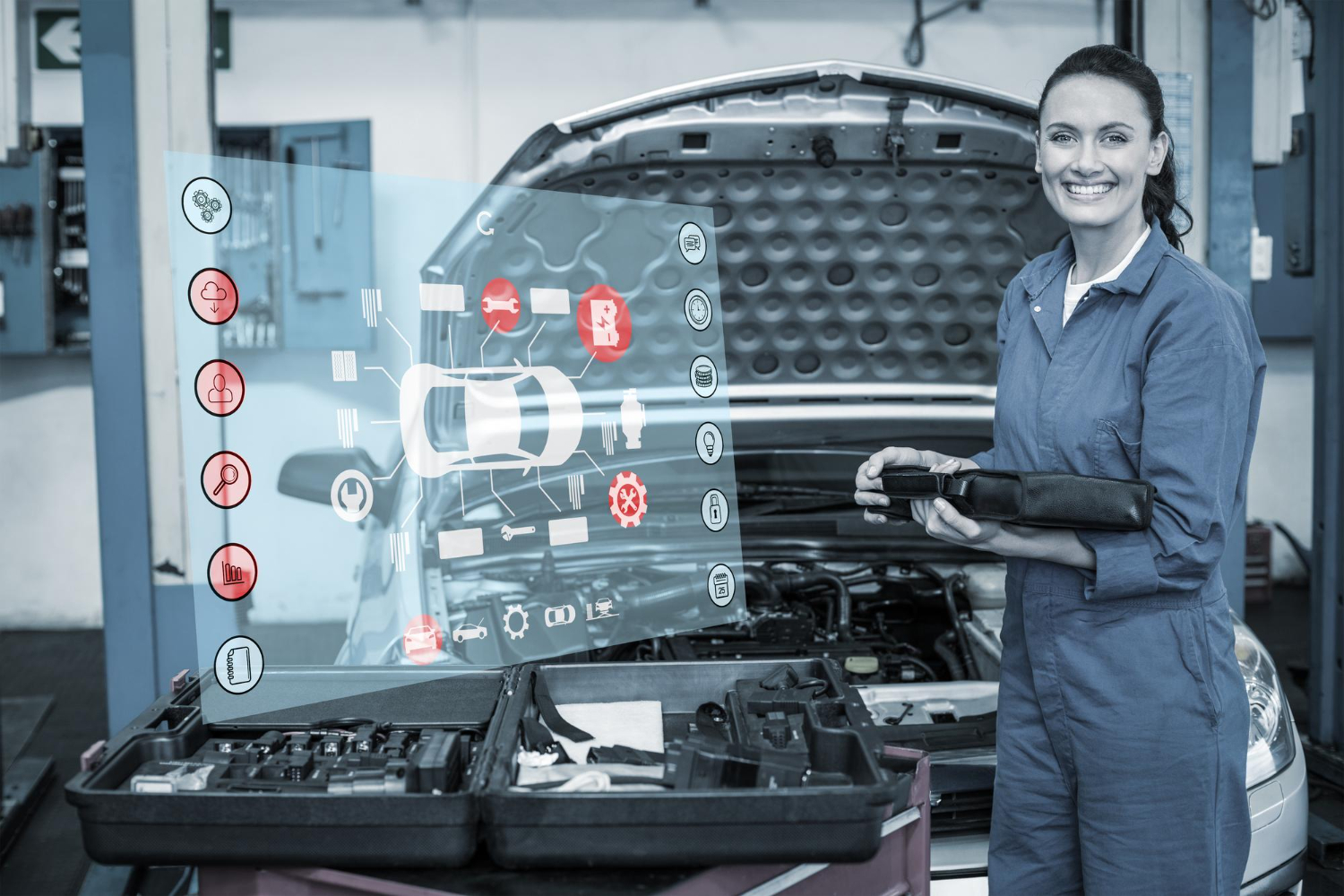AI-based predictive maintenance for fleets is revolutionising the way businesses manage their vehicles. With the power of artificial intelligence, fleet managers can now predict and prevent mechanical failures before they occur, saving both time and money.
In today’s competitive logistics and transportation landscape, efficiency and cost control are paramount. Businesses of all sizes are constantly seeking ways to optimise their fleets, and a revolutionary technology is emerging as a game-changer: artificial intelligence (AI)-based predictive maintenance.
This article explores the concept, benefits, future prospects, and above all, the implementation of AI-based predictive maintenance solutions tailored for fleets.
Moving from Reactive to Predictive: The Power of AI
Traditional fleet maintenance relies on scheduled servicing, regardless of a vehicle’s actual condition. This can lead to unnecessary repairs, overlooked issues, and, worse yet, unexpected breakdowns that cause delays and disrupt operations. AI-based predictive maintenance flips the script.
What is AI-based predictive maintenance for fleets?
Predictive maintenance for fleets involves monitoring the condition of vehicles and equipment in real-time to anticipate maintenance needs.
AI-based predictive maintenance adopts a proactive approach. By analysing data from onboard diagnostics (OBD-II) sensors, GPS trackers, maintenance records, and even weather patterns, AI algorithms can learn the unique fingerprint of each vehicle. Specifically, AI can analyse engine performance, fuel consumption, driving habits, and environmental factors. This allows for:
- Early detection of problems: AI can identify subtle changes in engine performance, fuel consumption, or vibration patterns that might signal a developing issue.
- Predictive maintenance scheduling: Instead of a one-size-fits-all approach, AI pinpoints the optimal time for servicing each vehicle, maximising component lifespan and minimising downtime.
- Reduced maintenance costs: By addressing problems before they become major failures, businesses can save on expensive repairs and part replacements.
AI algorithms can analyse engine performance, fuel consumption, driving habits, and environmental factors. This rich data pool allows fleet managers to identify potential issues and take preventive action to avoid costly breakdowns.
What are the benefits of AI in predictive maintenance?
The advantages of implementing AI-based predictive maintenance are numerous:
- Reduced Downtime: By proactively identifying and addressing potential problems, AI can significantly reduce the risk of unexpected breakdowns. This translates to fewer repairs on the side of the road, smoother operations, and happier customers.
- Lower Maintenance Costs: Predictive maintenance allows for targeted repairs, eliminating the need for unnecessary replacements or premature servicing. This proactive approach reduces repair expenses and extends the lifespan of fleet vehicles, resulting in significant cost savings for fleet operators.
- Extended Vehicle Lifespan: By catching problems early on, AI helps prevent damage from cascading into more serious issues. This translates to a longer lifespan for your fleet vehicles. This increased vehicle uptime translates to improved productivity and customer satisfaction, as vehicles are available when needed to fulfil delivery schedules and service commitments.
- Improved Safety: Predictive maintenance enhances vehicle safety by identifying and addressing potential mechanical issues before they escalate into safety hazards. By keeping fleet vehicles in optimal condition, AI-driven solutions help prevent accidents and ensure the safety of drivers, passengers, and other road users.
- Data-Driven Decision Making: AI provides valuable insights into fleet performance, enabling data-driven decisions regarding maintenance schedules, resource allocation, and vehicle replacement strategies.
What are the challenges and considerations in predictive maintenance?
One of the key challenges in implementing AI-based predictive maintenance is ensuring the privacy and security of sensitive data collected from fleet vehicles. Fleet operators must establish robust cybersecurity measures to protect data against unauthorised access and ensure compliance with data privacy regulations.
Integrating AI-driven predictive maintenance solutions with existing fleet management systems can be complex and time-consuming. Fleet operators must invest in interoperable technologies and seamless integration processes to ensure the smooth implementation and operation of predictive maintenance capabilities.
Most importantly, fleet operators must navigate regulatory frameworks and compliance requirements when implementing AI-based predictive maintenance solutions. Fleet operators must adhere to regulations governing data privacy, cybersecurity, and vehicle maintenance standards to ensure legal and regulatory compliance at all times.

Implementing AI-based Predictive Maintenance
By following these steps and continuously adapting, fleet managers can leverage AI-powered predictive maintenance to optimise operations, reduce costs, and ensure the smooth running of their fleets.
1. Assess Your Fleet Data Infrastructure
AI thrives on data. That’s why the first step in implementing AI-based predictive maintenance is collecting and analysing data from fleet vehicles. This involves installing sensors and telematics devices to capture data on vehicle performance, usage patterns, and environmental conditions. Also, evaluate your data storage capacity. AI systems require significant storage to house historical records and real-time sensor information.
2. Develop a Data Strategy
Plan how you will collect vehicle data from sensors and integrate it with the AI fleet management software. Determine how long you will store historical data to ensure the AI algorithms have a robust dataset for accurate predictions. Establish protocols for data security to protect sensitive information.
3. Predictive Model Development
Once data is collected, machine learning algorithms are used to develop predictive models that can forecast maintenance needs based on historical data and real-time inputs. These models are continuously refined and updated to improve accuracy and reliability over time.
4. Start Small and Scale Up
Consider implementing the AI programme on a pilot basis with a small portion of your fleet. This allows you to test the system’s effectiveness and identify any teething issues before full-scale deployment. As you gain confidence and experience success with the pilot programme, you can gradually integrate AI-powered predictive maintenance across your entire fleet.
5. Maintenance Planning and Execution
Regularly review and refine your data strategy as your fleet and technology evolve. Predictive maintenance insights proactively plan and execute maintenance activities, scheduling repairs and replacements based on predicted failure probabilities and criticality. Consequently, invest in employee training to ensure your maintenance team understands how to interpret AI alerts and recommendations.
6. Research and Choose an AI Fleet Management Solution Provider
When everything seems complicated, we recommend that you start your implementation by searching for companies offering AI-based fleet management solutions and services. Research these solutions to find one that best suits your fleet size, budget, and specific needs. Look for features like:
- Compatibility with your existing vehicle data (telematics systems)
- User-friendly interface for data analysis and maintenance scheduling
- Customisation options for alerts and reporting
Future of AI in Fleet Management, Logistics, and Transportation
The impact of AI on fleet management is undeniable. And we can say that AI is not just a trend; it is the future of fleet management. As AI technology advances, we can expect even greater benefits and more sophisticated predictive maintenance solutions. Here’s a glimpse into the future:
- Real-time Monitoring: AI will enable real-time monitoring of fleet health, allowing for immediate intervention when issues arise.
- Enhanced Diagnostics: AI will analyse data with even greater precision, pinpointing the root cause of potential problems and enabling more targeted repairs.
- Self-Diagnosing Vehicles: Vehicles will become even more intelligent, capable of self-diagnosing problems and communicating maintenance needs directly to fleet managers.
- Dynamic Route Optimisation: AI will factor in vehicle health and performance data when optimising routes, ensuring efficient and safe journeys.
- Integration with Other Technologies: AI will seamlessly integrate with other technologies like autonomous vehicles, further optimising logistics and transportation operations.
Investing in the Future: Getting Started with AI-based Predictive Maintenance
AI-based predictive maintenance is no longer a futuristic concept but a practical solution that offers significant benefits for businesses of all sizes in the logistics and transportation industries.
The good news is that AI-powered predictive maintenance solutions are becoming increasingly accessible for businesses of all sizes. This technology is paving the way for a future of optimised fleets, reduced costs, and a safer transportation landscape for everyone.
Here’s how to get started:
- Research AI fleet management solutions: Hexicor offers AI-powered fleet management solutions.
- Assess your fleet data: Hexicor provides a comprehensive suite of tools for collecting and visualising data.
- Develop a data strategy: Hexicor’s Data Analysis & Augmentation services provide valuable insights into where you stand and how you can improve.
If you’re looking to optimise your fleet operations and navigate the future of transportation, consider implementing AI-based predictive maintenance today. Certainly, it’s an investment that will pay dividends for years to come. Contact Hexicor to learn how to navigate the future with confidence.
Frequently Asked Questions about AI-based predictive maintenance
What is AI-based predictive maintenance, and how does it work?
- AI-based predictive maintenance utilises artificial intelligence and machine learning algorithms to analyse data from fleet vehicles and predict maintenance needs before breakdowns occur, enabling proactive maintenance strategies and reducing downtime.
Is AI-based predictive maintenance suitable for all types of fleets?
- Various fleet sizes and industries can adapt AI-based predictive maintenance.
What are the benefits of AI-driven predictive maintenance for fleets?
- AI-driven predictive maintenance offers several benefits for fleets, such as cost savings, increased vehicle uptime, and improved safety through early detection and prevention of mechanical issues.
How accurate is AI-based predictive maintenance?
- AI algorithms can achieve high levels of accuracy in predicting maintenance needs.
What challenges do fleet managers face when implementing AI-based predictive maintenance?
- Fleet managers face challenges such as data privacy and security, integration complexity with existing systems, and regulatory compliance when implementing AI-based predictive maintenance solutions.
How can fleet managers ensure the successful implementation of AI-driven predictive maintenance solutions?
- By making investments in predictive analytics and proactively organising and carrying out maintenance tasks based on predicted insights, fleet operators can guarantee the effective adoption of AI-driven predictive maintenance.
What is the future of AI-based predictive maintenance?
- Machine learning will advance in AI-based predictive maintenance and real-time monitoring will use the Internet of Things (IoT). In addition, fleet management systems will increasingly self-diagnose and schedule maintenance tasks.











